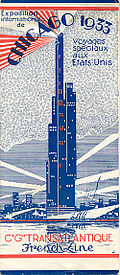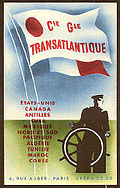- Compagnie Générale Transatlantique
-
"French Line" redirects here. The term also refers to a track through the Simpson Desert in Australia.
The Compagnie Générale Transatlantique (shortened to "CIE. GLE. TRANSATLANTIQUE", or CGT, and commonly named "Transat"), typically known overseas as the French Line, was a shipping company established during 1861 as an attempt to revive the French merchant marine, the poor state of which was indicated during the Crimean War of 1856. The company's first vessel, the SS Washington, had its maiden voyage on 15 June 1864. Other than operating ocean liners, the company also had a significant fleet of freighters. The company survived both World Wars, but the development of jet travel doomed its mainstay passenger liner business. During 1977 the company merged with the Compagnie des Messageries Maritimes to form the Compagnie Générale Maritime. During 1996 the company Compagnie Générale Maritime merged to form the CMA CGM.
Contents
History
During 1855, the Péreire brothers, Emile and Isaac, created the Compagnie Générale Maritime, which later became the Compagnie Générale Transatlantique. They were already the owners of the Société Générale de Crédit Mobilier, which became the main shareholder. Five years later they signed an agreement with the French government. The company contracted to create a fleet and to provide liner service and carry mail for 20 years on the following routes: Le Havre - New York with calls at Brest, Saint-Nazaire, and the Isthmus of Panama, with 3 additional services for Guadeloupe, Mexico and Cayenne. In return, the government would provide the company with an annual subsidy.
During 1861 Compagnie Générale Maritime changed its name to the Compagnie Générale Transatlantique. The Pereire brothers also established a shipyard at Penhoët, near Saint-Nazaire. The next year the first trip to the West Indies and Mexico was made by the ship Louisiane. Two years later the New York - Le Havre line service was begun, with the paddle-steamer Washington providing postal service. During 1867 the company switched from using paddle wheels to using propellers for its vessels, partly because they were more fuel efficient.
An economic and financial crisis during 1868 forced the Pereire brothers to file a petition of bankruptcy and to resign from the company's board. However, the company survived.
Technical progress continued and the company modified its vessels to transport more goods. Still, during 1873 the line suffered its first major accident. The Ville du Havre collided with the sailing ship Loch Earn, with a loss of life of about 226 people.
During 1879 the French government awarded the company the concession for postal services for the Mediterranean. That same year the company incorporated. Between 1882 and 1884 the government renewed the earlier fleet and postal agreements.
During 1886 SS La Bourgogne traveled the le Havre - New York transit in a little more than 7 days. This gave the company first place in the New York postal service, and began a competition for the record in the trans-Atlantic run. During 1894 the company offered the first cruise for American passengers when La Touraine initiated service from New York to Constantinople.
Between 1897 and 1904, European competition intensified and the company suffered two major maritime disasters. The Ville de Saint-Nazaire had to be abandoned at sea during 1897 and La Bourgogne sank with 568 passengers during 1898. Furthermore, labor strife developed as strikes came to affect all ports and all staff. The strikes continued until 1923.
During 1904 Jules Charles-Roux became president and instituted a reorganization. The company re-oriented its strategy to emphasize the quality of life aboard ship rather than racing against time. The next year it initiated Le Havre - New York cargo service.
The company did not become a major participant of the trans-Atlantic ocean liner trade until after World War I. During 1907 and 1908, when immigration to the United States was greatest, the company's share of the market was a mere 10%. In line with its strategy, the company did not have ships of either great speed or size, but instead became renowned during the early 20th century for its luxuriously appointed liners. The most notable of these early ships was the SS France, which began service during 1912.
During World War I the company transformed its vessels into warships, hospital vessels and troopships. By the end of the war, the company had lost a third of the fleet. Still, the company recovered during the post-war period, with several famous ships beginning service. During 1927, the SS Ile de France, the first ship to be styled in Art Deco, had its maiden voyage.
The company also diversified. During 1919 it introduced the first tourist motor car circuit in North Africa and during 1925 it created the Société des Voyages et Hôtels Nord-Africains (S.V.H.N.A.).
The Great Depression caused the company to suffer a significant decrease of profits as costs increased and passenger numbers decreased. The company responded by decommissioning vessels and discontinuing unprofitable routes. A generous government subsidy enabled the company, during 1935, to finance the construction its most famous vessel, the SS Normandie. At the time of completion, the ship was the largest in the world and also the fastest, winning the Blue Riband from the Italian liner, the SS Rex. Its Art Deco interior and streamlined hull design were famous. It won the Blue Ribbon trophy for its first voyage with a speed of 30 knots. However, it was never a commercial success and a fire during 1942 ended its career.
During 1939-1940, at the beginning of World War II, the company was subject to mobilization of more than a third of the staff. The Department of Shipping & Maritime Transport chartered or requisitioned the company's ships. The company also received 95 vessels to manage for the war effort. By 1946, the loss of several vessels due to the war had diminished the company's fleet, though the company was able to acquire several Liberty ships. The company also acquired Liberté, the former German liner SS Europa, which France had claimed as reparations.
Passenger traffic grew post-war, but the beginning of commercial air travel during 1958 was a disaster for the French Line's passenger ships. Despite the launch of a new flagship, the 66,000 ton SS France during 1961, passenger demand decreased as no ship could match the convenience of airplane flights that could transport passengers in a matter of hours over a distance that by ship would take several days. The ocean liner fleet became dependent on government subsidies, which were finally ended during 1974. The fleet was subsequently hulked.
France was laid up until 1979 when the Norwegian Cruise Line bought it and renamed it Norway. During 2008, Norway was beached at Alang, India and broken for scrap.
During 1977 the company merged with the Compagnie des Messageries Maritimes to form the Compagnie Générale Maritime.
Vessels
CGT Ships included:
- Halifax Explosion.
- SS France (1910)
- SS Illinois (1917) formerly SS Farnworth, bought and renamed in 1926, sold in 1934 and torpedoed in 1940 as SS Empire Conveyor
- SS Paris
- SS Pensylvanie (1917), sold to Counties Ship Management in 1934 and renamed SS Bury Hill, wrecked off the Senegalese coast in 1936
- SS De Grasse (1924-1953), renamed the RMS Empress of Australia by Canadian Pacific Steamships
- SS Ile de France
- SS Normandie (1932–42), re-named USS Lafayette by the US Navy; damaged beyond repair by fire in New York
- SS Ingénieur Général Haarbleicher (1945), ran agroud 1945, scrapped 1947.
- SS Liberté (formerly SS Europa of North German Lloyd)
- SS Antilles
- SS Flandre
- SS France (1961) (later sold to Norwegian Cruise Line and re-named SS Norway.)
Further reading
- Miller, William H. Jr., The First Great Ocean Liners in Photographs, 1984, Dover
- Fox, Robert, Liners, the Golden Age, 1999, Könemann
- McAuley, Robert, The Liners, 1997, Boxtree
- Maddocks, Melvin, The Great Liners, 1978, Time-Life
External links
- Passenger Lists of the CGT French Line
- Official website
- French Lines
- The Last Ocean Liners - French Line - trade routes and ships of the French Line during the 1960s and 1970s.
Compagnie Générale Transatlantique (French Line) ships Tampico (1862) · Floride (1862) · Cacique (1862) · Louisiane (1862) · Lafayette (1864) · France (1864) · Washington (1864) · Europe (1865) · Impératrice Eugénie (1865) · Nouveau Monde (1865) · Guyane (1865) · Caraïbe (1866) · Darien (1866) · Napoléon III (1866) · Saint-Laurent (1866) · Péreire (1866) · Panama (1866) · Martinique (1869) · Atlantique (1870) · Guadeloupe (1870) · Amérique (1873) · Colombie (1874) · Canada (1875) · Saint-Germain (1876) · Saint-Simon (1878) · Olinde Rodrigues (1878) · # Saint-Domingue (1879) · Ferdinand-de-Lesseps (1879) Charles-Quint (1880) · Abd El-Kader (1880) · Moïse (1880) · Saint-Augustin (1880) · Fournel (1880) · Isaac-Pereire (1880) · Kléber(1880) · Malvina (1881) · Maréchal Canrobert (1881) · Mohamed Es Sadock (1881) · Lou Cettori (1881) · La Corse (1881) · Afrique (1881) · Ajaccio (1881) · Bastia (1881) · La Bretagne (1886) · La Champagne (1886) · La Gascogne (1886) · Eugène-Péreire (1888) · Duc de Bragance (1889) · Maréchal Bugeaud (1890) · Général Chanzy (1892) · La Navarre (1893) · Labrador (1895) · L'Aquitaine (1899) · Paris (1921) · De La Salle (1921) · Pologne (1921) · Gouverneur Général Chanzy (1922) · Gouverneur Général Grévy (1922) · Pellerin de Latouche (1923) · Gouverneur Général Jonnart (1923) · Cuba (1923) · De Grasse (1924) · Gouverneur Général De Gueydon (1924) · Île de France (1927) · Président Dal Piaz (1929) · Guadeloupe (1929) · Lafayette (1930) · Liberté · Colombie (1931) · Champlain (1932) · Saint-Domingue (1932) · Normandie (1935) · Bretagne (1936) · Lieutenant J Le Meur (1946) · Fred-Scamaroni (I) (1948) · Commandant-Quéré (1948) · Cyrnos (1948) · Gascogne (1949) · Maroc (1951) · Flandre (1952) · Antilles (1953) · Napoléon (1959) · France (1962) · Comté-de Nice (1966) · Corse (1966) · Fred-Scamaroni (II) (1966) · Méditerranée (1970) · De Grasse (1971)
Categories:
Wikimedia Foundation. 2010.



